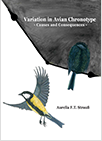PhD defence Aurelia Strauss
| When: | Tu 09-07-2024 at 16:15 |
| Where: | Academy Building & online |
Aurelia Strauss (Neurobiology)
Promotores: Prof. B Helm, Prof. M.E. Visser (NIOO); copromotor: Dr B. Tomotani (UiT/NIOO)

Variation in avian chronotype
Causes and consequences
Early birds and night owls are common descriptions for people with different sleep-awake habits. Indeed, individuals can consistently differ in their activity pattern (= chronotype) depending on their genetics and the environmental conditions. The underlying driver of these rhythms is the internal clock which adjusts its own speed to the day-night light patterns generating physiological and behavioural rhythms of 24 h. Additionally, these rhythms flexibly respond to environmental changes. Here, I studied the causes and consequences of individual differences and individuals’ responsiveness in chronotype using the great tit. I monitored and manipulated activity patterns of wild great tits in winter and during the breeding season. As causes of variation I identified plastic responses to environmental factors such as season, weather, conspecifics and artificial light. Nevertheless, great tits had consistently different chronotypes. However, these individual differences were unrelated to differences found in the speed of their internal clocks. Additional variation between individuals might come from other components of the clock’s mechanism such as the cue perception and the clock’s flexibility. All components combined generate the consistent individual differences observed. When assessing consequences of variation, I found that females with different chronotypes showed no differences in reproductive success. However, when I disrupted the females’ rhythms by exposing them to artificial light at night, they had lower body weights indicating physiological costs. This project contributes to understanding variation in daily timing indicating complex clock-chronotype relationships and highlights the importance of the synchronisation of the individual’s timing with the environment.
